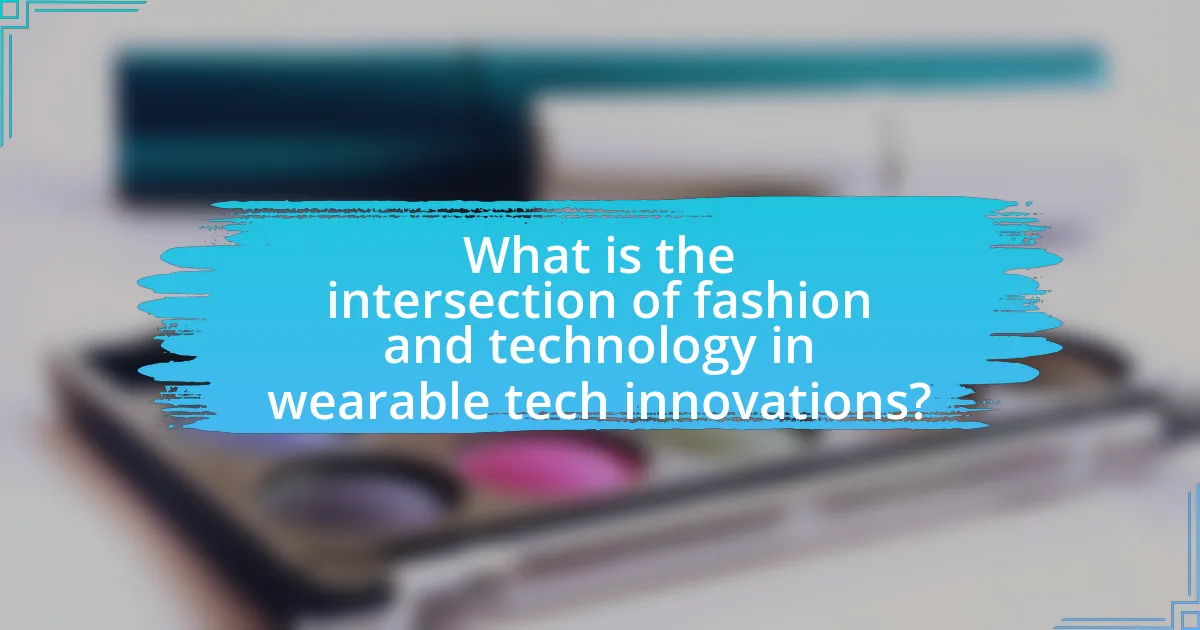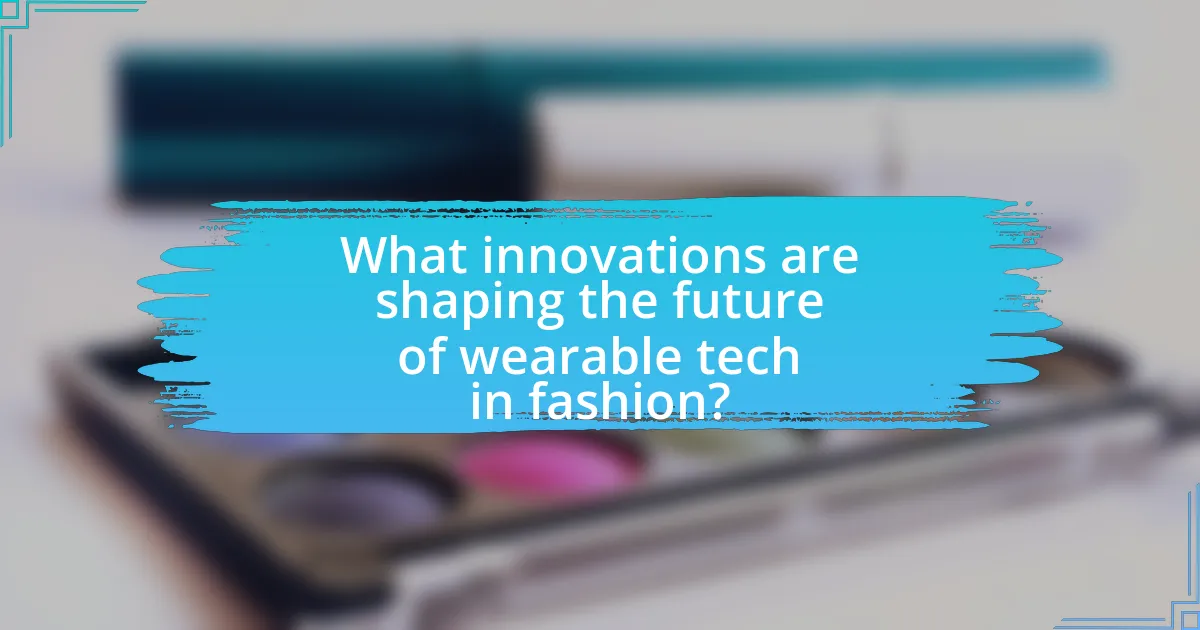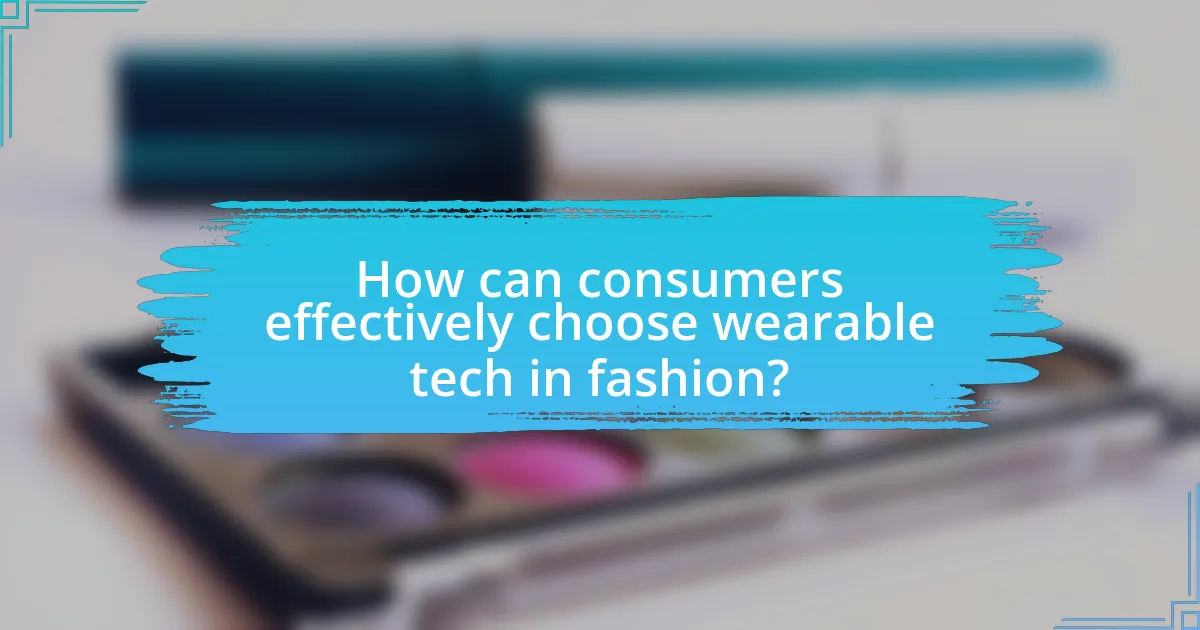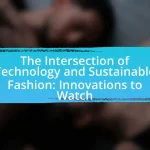The article explores the intersection of fashion and technology through wearable tech innovations, highlighting how aesthetic design and functional technology converge to enhance user experience. It discusses the evolution of wearable technology in the fashion industry, key milestones in its development, and how fashion designers incorporate technology into their designs. The article also examines various types of wearable tech, including smartwatches and fitness trackers, and addresses challenges such as privacy concerns and technological limitations. Additionally, it outlines emerging trends, successful collaborations between tech companies and fashion brands, and future predictions for the wearable tech market, emphasizing consumer preferences and the impact of advancements in technology on fashion trends.

What is the intersection of fashion and technology in wearable tech innovations?
The intersection of fashion and technology in wearable tech innovations lies in the integration of aesthetic design with functional technology to create products that enhance user experience and lifestyle. Wearable tech, such as smartwatches and fitness trackers, combines stylish elements with advanced features like health monitoring and connectivity, appealing to both fashion-conscious consumers and tech enthusiasts. For instance, the Apple Watch, which features customizable bands and faces, exemplifies how technology can be seamlessly incorporated into everyday fashion, while also providing functionalities like heart rate tracking and notifications. This convergence not only drives consumer interest but also fosters collaborations between fashion designers and tech companies, leading to innovative products that redefine personal style and functionality.
How has wearable technology evolved in the fashion industry?
Wearable technology in the fashion industry has evolved significantly from basic fitness trackers to sophisticated smart garments. Initially, wearable tech focused on functionality, such as tracking physical activity and health metrics, exemplified by devices like the Fitbit, launched in 2009, which popularized fitness monitoring. Over time, fashion brands began integrating technology into clothing, leading to innovations like smart textiles that can change color or regulate temperature, as seen in projects like the Google and Levi’s Jacquard jacket introduced in 2017. This evolution reflects a growing consumer demand for products that blend style with technology, evidenced by the increasing collaborations between tech companies and fashion designers, such as the partnership between Apple and Hermès for the Apple Watch bands. The market for wearable technology in fashion is projected to reach $100 billion by 2024, highlighting its rapid growth and acceptance within the industry.
What are the key milestones in the development of wearable tech?
Key milestones in the development of wearable tech include the introduction of the first digital watch in 1972, the Seiko Data 2000, which allowed users to store data. In 1998, the first wearable computer, the Wearable Wireless Webcam, was developed, enabling video capture on the go. The launch of the Fitbit in 2009 marked a significant advancement in fitness tracking, popularizing health-focused wearables. In 2015, the Apple Watch was released, integrating smartwatch capabilities with health monitoring features, further driving consumer adoption. These milestones illustrate the evolution of wearable technology from basic devices to sophisticated health and fitness trackers.
How do fashion designers incorporate technology into their designs?
Fashion designers incorporate technology into their designs by integrating smart textiles, 3D printing, and digital design tools. Smart textiles, such as fabrics embedded with sensors, allow garments to monitor health metrics or change color based on environmental conditions. For example, companies like Wearable X have developed yoga pants that provide feedback on posture through embedded sensors.
3D printing enables designers to create intricate patterns and structures that would be impossible with traditional methods, allowing for customization and rapid prototyping. Notably, brands like Adidas have utilized 3D printing to produce shoes tailored to individual foot shapes, enhancing comfort and performance.
Digital design tools, including software for virtual fitting and augmented reality, allow designers to visualize and modify their creations in real-time, streamlining the design process. This technological integration not only enhances creativity but also improves efficiency in production and reduces waste in the fashion industry.
What are the primary types of wearable tech in fashion?
The primary types of wearable tech in fashion include smartwatches, fitness trackers, smart clothing, and augmented reality accessories. Smartwatches, such as the Apple Watch, integrate health monitoring and communication features, while fitness trackers like Fitbit focus on activity and health metrics. Smart clothing incorporates technology into fabrics for functions like temperature regulation or biometric monitoring, exemplified by brands like Athos. Augmented reality accessories, such as smart glasses from Google, enhance user experiences by overlaying digital information onto the physical world. These categories represent significant advancements in merging technology with fashion, reflecting a growing trend in the industry.
What are smartwatches and how do they integrate with fashion?
Smartwatches are wearable devices that combine the functionality of traditional watches with advanced technology, allowing users to perform tasks such as tracking fitness, receiving notifications, and accessing apps. They integrate with fashion by offering customizable designs, interchangeable bands, and collaborations with fashion brands, making them not only functional but also stylish accessories. For instance, brands like Apple and Samsung have partnered with luxury designers to create limited-edition smartwatches that appeal to fashion-conscious consumers, demonstrating that technology can coexist with high fashion.
How do fitness trackers blend functionality with style?
Fitness trackers blend functionality with style by incorporating advanced technology into aesthetically pleasing designs. These devices often feature customizable watch faces, interchangeable bands, and sleek profiles that appeal to fashion-conscious consumers. For instance, brands like Fitbit and Apple offer various styles that cater to different tastes, from sporty to elegant, ensuring that users can wear them in diverse settings, including workouts and formal occasions. This integration of technology and fashion is supported by market trends indicating that 70% of consumers prioritize design alongside functionality when purchasing wearable tech.
What role do smart fabrics play in wearable technology?
Smart fabrics serve as a foundational component in wearable technology by integrating electronic components and sensors into textiles, enabling functionalities such as health monitoring, temperature regulation, and data collection. These fabrics can detect physiological signals, such as heart rate and body temperature, and transmit this data to connected devices for real-time analysis. For instance, a study published in the journal “Advanced Materials” highlights how smart textiles can monitor vital signs and enhance athletic performance through embedded sensors, demonstrating their significant role in advancing wearable technology.
What challenges does the fashion industry face with wearable tech?
The fashion industry faces significant challenges with wearable tech, primarily related to integration, consumer acceptance, and technological limitations. Integration poses difficulties as designers must merge aesthetics with functionality, often leading to compromises in style or comfort. Consumer acceptance is another hurdle, as many potential users are hesitant to adopt wearable tech due to concerns about privacy, data security, and the perceived complexity of use. Additionally, technological limitations, such as battery life, durability, and the need for constant updates, hinder the development of reliable and appealing products. These challenges are underscored by market research indicating that while the wearable tech market is projected to grow, consumer skepticism remains a barrier to widespread adoption.
How do privacy concerns affect the adoption of wearable technology?
Privacy concerns significantly hinder the adoption of wearable technology. Many potential users fear that their personal data, such as health metrics and location information, may be misused or inadequately protected. A survey conducted by the Pew Research Center in 2021 revealed that 60% of Americans expressed discomfort with the idea of companies collecting data from wearable devices. This apprehension leads to a reluctance to invest in or utilize such technologies, as individuals prioritize their privacy and security over the benefits offered by wearables.
What are the limitations of current wearable tech in fashion?
Current wearable tech in fashion faces limitations such as battery life, comfort, and integration with existing clothing. Battery life often restricts the duration of use, with many devices requiring frequent recharging, which can be inconvenient for users. Comfort is another issue, as many wearable devices can be bulky or heavy, making them less appealing for everyday wear. Additionally, integration with existing clothing remains a challenge, as many wearables do not seamlessly blend with fashion aesthetics, limiting their adoption. These limitations hinder the widespread acceptance and functionality of wearable technology in the fashion industry.
How does wearable tech influence consumer behavior in fashion?
Wearable tech significantly influences consumer behavior in fashion by integrating functionality with style, leading to increased consumer engagement and purchasing decisions. The rise of smartwatches, fitness trackers, and smart clothing has shifted consumer expectations towards products that offer both aesthetic appeal and technological benefits. For instance, a study by McKinsey & Company found that 70% of consumers are more likely to purchase fashion items that incorporate technology, highlighting a growing trend where consumers prioritize innovation alongside traditional fashion elements. This shift not only enhances the shopping experience but also encourages brands to innovate, ultimately shaping the future of fashion retail.
What trends are emerging from the integration of fashion and technology?
Emerging trends from the integration of fashion and technology include the rise of smart textiles, augmented reality (AR) in retail, and sustainable fashion innovations. Smart textiles, such as fabrics embedded with sensors, enable functionalities like monitoring health metrics or adjusting temperature, enhancing user experience. Augmented reality is transforming retail by allowing customers to virtually try on clothing, improving engagement and reducing return rates. Additionally, sustainable fashion is increasingly utilizing technology for eco-friendly production methods, such as 3D printing and digital design, which minimize waste and resource consumption. These trends reflect a significant shift towards functionality, interactivity, and sustainability in the fashion industry.
How do consumers perceive the value of wearable tech in fashion?
Consumers perceive the value of wearable tech in fashion as a blend of functionality and style, enhancing both personal expression and convenience. This perception is supported by a growing trend where 70% of consumers express interest in integrating technology into their clothing, valuing features such as health monitoring and connectivity. Additionally, wearable tech is seen as a status symbol, with luxury brands increasingly incorporating smart features, thus appealing to consumers’ desire for exclusivity and innovation.

What innovations are shaping the future of wearable tech in fashion?
Innovations shaping the future of wearable tech in fashion include smart textiles, augmented reality (AR), and health-monitoring devices. Smart textiles integrate sensors and electronics into fabrics, allowing for functionalities such as temperature regulation and moisture management. For instance, companies like Wearable X have developed clothing that can guide users through yoga poses using haptic feedback. Augmented reality enhances the shopping experience by allowing consumers to virtually try on clothes, as seen in apps like Zara’s AR feature. Health-monitoring devices, such as smartwatches and fitness trackers, provide real-time data on physical activity and health metrics, with brands like Fitbit leading the market. These innovations not only enhance user experience but also drive sustainability by enabling more efficient production processes and personalized fashion solutions.
How are advancements in technology driving new fashion trends?
Advancements in technology are driving new fashion trends by enabling the integration of wearable tech, which enhances functionality and personalization in clothing. For instance, smart fabrics equipped with sensors can monitor health metrics, allowing consumers to blend style with wellness. According to a report by McKinsey & Company, the global market for wearable technology is projected to reach $60 billion by 2023, indicating a significant consumer interest in tech-infused fashion. Additionally, innovations such as 3D printing allow designers to create unique, customized pieces that cater to individual preferences, further shaping contemporary fashion trends.
What role does artificial intelligence play in wearable fashion tech?
Artificial intelligence plays a crucial role in wearable fashion tech by enhancing personalization, functionality, and user experience. AI algorithms analyze user data, such as preferences and biometric information, to create customized fashion recommendations and optimize the performance of wearable devices. For instance, smart clothing equipped with AI can monitor health metrics, adjust temperature, or provide feedback on posture, thereby improving user comfort and well-being. Additionally, AI-driven design tools enable fashion designers to predict trends and streamline production processes, leading to more efficient and innovative designs. This integration of AI in wearable fashion tech not only elevates the functionality of the products but also aligns them with consumer needs and market demands.
How are augmented and virtual reality changing the shopping experience?
Augmented and virtual reality are transforming the shopping experience by enabling immersive interactions that enhance customer engagement and decision-making. Retailers are utilizing augmented reality to allow customers to visualize products in their own environment, such as trying on clothes virtually or placing furniture in their homes before purchase. For instance, IKEA’s app lets users see how furniture fits in their space, leading to increased customer satisfaction and reduced return rates. Virtual reality, on the other hand, creates fully immersive shopping environments where customers can explore virtual stores and interact with products as if they were physically present. A study by Deloitte found that 40% of consumers are willing to pay more for a product if they can experience it through augmented reality. This integration of technology not only enhances the shopping experience but also drives sales and customer loyalty.
What collaborations are taking place between tech companies and fashion brands?
Tech companies and fashion brands are collaborating on various innovative projects, notably in the realm of wearable technology. For instance, Google partnered with Levi’s to create the Jacquard jacket, which integrates touch-sensitive technology to control smartphones. Similarly, Apple has collaborated with Hermès to produce luxury Apple Watch bands that blend high fashion with advanced technology. Another significant collaboration is between Adidas and Parley for the Oceans, where they utilize recycled ocean plastic in their footwear, showcasing a commitment to sustainability through technology. These partnerships illustrate the merging of fashion aesthetics with technological advancements, enhancing functionality and user experience.
How do partnerships enhance the development of wearable tech?
Partnerships enhance the development of wearable tech by combining expertise from different industries, leading to innovative solutions and faster product development. For instance, collaborations between technology companies and fashion brands result in products that not only incorporate advanced technology but also meet consumer aesthetic preferences. A notable example is the partnership between Apple and Hermès, which produced the Apple Watch Hermès, merging luxury fashion with cutting-edge technology. This collaboration demonstrates how partnerships can leverage distinct strengths, such as design and engineering, to create unique wearable tech that appeals to a broader market.
What successful examples of collaboration exist in the industry?
Successful examples of collaboration in the fashion and technology industry include the partnership between Nike and Apple, which resulted in the Nike+ product line that integrates fitness tracking with athletic footwear. This collaboration has led to significant advancements in wearable technology, allowing users to monitor their performance through a seamless connection between their shoes and Apple devices. Another notable example is the collaboration between Google and Levi’s, which produced the Jacquard jacket, enabling users to control their smartphones through gestures on the fabric. These partnerships illustrate how combining expertise from both sectors can lead to innovative products that enhance user experience and functionality in wearable tech.
What are the future predictions for wearable tech in fashion?
Future predictions for wearable tech in fashion indicate a significant integration of smart textiles and augmented reality, enhancing user experience and functionality. The market for wearable technology in fashion is expected to grow substantially, with estimates projecting a compound annual growth rate (CAGR) of over 15% from 2023 to 2030, driven by advancements in materials and consumer demand for multifunctional apparel. Innovations such as health-monitoring fabrics and interactive clothing are anticipated to become mainstream, as brands increasingly collaborate with tech companies to create products that blend style with utility.
How might consumer preferences shape the next generation of wearable tech?
Consumer preferences will significantly shape the next generation of wearable tech by driving demand for features that prioritize functionality, aesthetics, and health monitoring. As consumers increasingly seek devices that seamlessly integrate into their daily lives, manufacturers will focus on creating wearables that are not only technologically advanced but also stylish and comfortable. For instance, a survey by Deloitte in 2022 indicated that 70% of consumers prefer wearables that offer health tracking capabilities, such as heart rate monitoring and sleep analysis, which suggests a strong market inclination towards health-oriented features. Additionally, the rise of customization options, as evidenced by brands like Apple and Fitbit allowing users to personalize watch faces and bands, reflects consumer desires for individuality in tech products. This trend indicates that future wearable tech will likely prioritize user-centric designs that align with personal style and health needs.
What innovations are on the horizon for smart clothing and accessories?
Innovations on the horizon for smart clothing and accessories include advanced fabric technologies, integrated health monitoring systems, and enhanced connectivity features. For instance, researchers are developing textiles that can change color or pattern based on environmental stimuli, such as temperature or light. Additionally, wearable devices are increasingly incorporating sensors that track vital signs, such as heart rate and body temperature, providing real-time health data to users. Companies like Google and Levi’s are also exploring smart fabrics that can interact with smartphones, allowing users to control devices through gestures on their clothing. These advancements reflect a growing trend towards merging functionality with fashion, aiming to enhance user experience and promote health and wellness.

How can consumers effectively choose wearable tech in fashion?
Consumers can effectively choose wearable tech in fashion by assessing functionality, style, compatibility, and brand reputation. Functionality is crucial; consumers should identify their specific needs, such as fitness tracking or notifications, to select devices that meet those requirements. Style matters as well; wearable tech should complement personal fashion preferences, ensuring that the device is both practical and aesthetically pleasing. Compatibility with existing devices, like smartphones or smart home systems, is essential for seamless integration. Lastly, considering brand reputation can guide consumers toward reliable products, as established brands often provide better customer support and product quality. Research indicates that 70% of consumers prioritize brand trust when purchasing tech products, reinforcing the importance of brand reputation in decision-making.
What factors should consumers consider when selecting wearable tech?
Consumers should consider compatibility, functionality, design, battery life, and price when selecting wearable tech. Compatibility ensures that the device works seamlessly with existing smartphones and apps, enhancing user experience. Functionality refers to the specific features offered, such as fitness tracking, health monitoring, or notifications, which should align with the consumer’s needs. Design is crucial as it affects both aesthetics and comfort, influencing daily wearability. Battery life is important for usability; longer battery life reduces the frequency of charging, making the device more convenient. Lastly, price should reflect the value and features offered, ensuring that consumers receive a good return on investment.
How do style and functionality impact consumer choices?
Style and functionality significantly impact consumer choices by influencing perceptions of value and usability. Consumers often prioritize products that not only meet their practical needs but also align with their aesthetic preferences. For instance, a study by the Journal of Fashion Marketing and Management found that 70% of consumers consider style as a critical factor when purchasing wearable technology, indicating that attractive design can enhance the perceived value of a product. Additionally, functionality plays a crucial role; products that effectively integrate features such as health tracking or connectivity are more likely to be favored. Research from the International Journal of Information Management highlights that 65% of consumers are willing to pay a premium for wearable tech that combines both style and advanced functionality, demonstrating that the intersection of these two elements directly influences purchasing decisions.
What are the best practices for integrating wearable tech into daily life?
The best practices for integrating wearable tech into daily life include setting clear goals for usage, ensuring compatibility with existing devices, and regularly updating software. Establishing specific objectives, such as tracking fitness or improving productivity, helps users maximize the benefits of wearable technology. Compatibility with smartphones and other devices enhances functionality, allowing for seamless data sharing and notifications. Regular software updates are crucial for security and performance improvements, ensuring that the wearable device operates efficiently and effectively. These practices are supported by user studies indicating that goal-oriented use increases engagement and satisfaction with wearable technology.
What are common troubleshooting tips for wearable tech users?
Common troubleshooting tips for wearable tech users include restarting the device, ensuring it is charged, checking for software updates, and verifying Bluetooth connections. Restarting can resolve temporary glitches, while a low battery may prevent proper functionality. Regular software updates are crucial as they often fix bugs and improve performance. Additionally, confirming that Bluetooth is enabled on both the wearable and the paired device ensures seamless connectivity. These steps are widely recommended by tech support resources and user manuals, highlighting their effectiveness in resolving common issues.
How can users maintain their wearable devices for longevity?
Users can maintain their wearable devices for longevity by regularly cleaning them, ensuring proper charging practices, and updating software. Regular cleaning prevents dirt and sweat buildup, which can damage sensors and screens; using a soft cloth and mild soap is effective. Proper charging practices, such as avoiding overcharging and using the recommended charger, help preserve battery life. Additionally, keeping the device’s software updated ensures optimal performance and security, as manufacturers often release updates that fix bugs and improve functionality. These maintenance steps are essential for extending the lifespan of wearable technology.
What should users do if they experience connectivity issues?
Users experiencing connectivity issues should first restart their device to refresh the connection. This action often resolves temporary glitches that may disrupt connectivity. If the problem persists, users should check their internet connection by ensuring that Wi-Fi or mobile data is enabled and functioning properly. Additionally, users can verify if the wearable device is within range of the connected device, as distance can affect connectivity. If these steps do not resolve the issue, users should consult the device’s user manual or support website for troubleshooting tips specific to their model, as different devices may have unique solutions for connectivity problems.
















